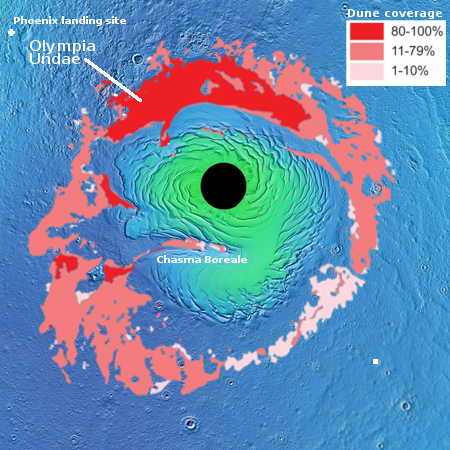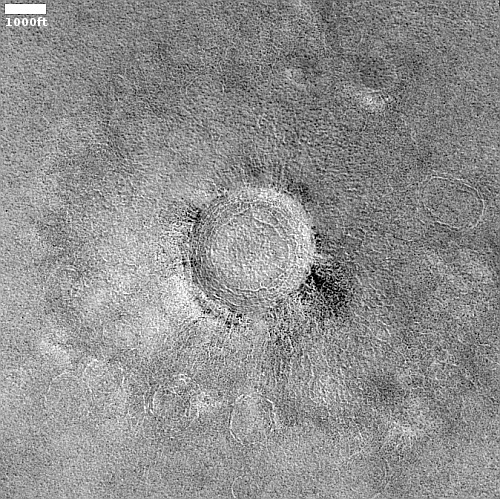Cracking pedestal crater near Mars’ north pole
Cool image time! The picture to the right, cropped, reduced, and sharpened to post here, was taken on March 18, 2023 by the high resolution camera on Mars Reconnaissance Orbiter (MRO). I have also rotated it so that north is to the top.
Labeled a “terrain sample” by the camera team, this picture was likely taken not as part of any specific research project, but to fill a gap in the camera’s schedule so as to maintain its proper temperature. As usual, when the camera team needs to do this, they try to pick a target of interest. Sometimes they succeed, sometimes not.
In this case, the picture is of a location only about 800 miles from the Martian north pole, on the northern lowland plains. While the section shown to the right focuses on the largest crater, the full picture includes a few others, all of which appear to have their interior floors cracking in the same way, and all appear to be pedestal craters, sitting above the surrounding terrain, though by not as much.

The white dot on the lower right of the overview map to the right marks this location. At this latitude, about 71 degrees north, it is very likely that the entire surface here is covered by an ice sheet that is further protected by a thin dust/debris layer.
In other words, we are looking at cracked ice. Since the picture was taken in the spring, it is also possible that it contains evidence of the spring dissipation of the dry ice mantle that covers the northern regions of Mars, down to about 60 degrees latitude, during the winter. I don’t see any obvious evidence of that dissipation, but then, I’m not a planetary scientist.
That these are all pedestal craters suggests two possible explanations for their origin. First, they might be impact craters that were pounded into a greater density during impact, and thus more resistant to erosion than the surrounding plains. Second, they might be some form of ice/water volcano, the crater actually a caldera where ice/water once pushed up from below.
Since impact or volcanic activity are generally the only two explanations for most craters, this information really tells us nothing. The geological processes in this part of Mars are little understood, as they involve the evolution of ice and material in an alien cold thin atmosphere on a planet with one third the gravity of Earth.
On Christmas Eve 1968 three Americans became the first humans to visit another world. What they did to celebrate was unexpected and profound, and will be remembered throughout all human history. Genesis: the Story of Apollo 8, Robert Zimmerman's classic history of humanity's first journey to another world, tells that story, and it is now available as both an ebook and an audiobook, both with a foreword by Valerie Anders and a new introduction by Robert Zimmerman.
The print edition can be purchased at Amazon or from any other book seller. If you want an autographed copy the price is $60 for the hardback and $45 for the paperback, plus $8 shipping for each. Go here for purchasing details. The ebook is available everywhere for $5.99 (before discount) at amazon, or direct from my ebook publisher, ebookit. If you buy it from ebookit you don't support the big tech companies and the author gets a bigger cut much sooner.
The audiobook is also available at all these vendors, and is also free with a 30-day trial membership to Audible.
"Not simply about one mission, [Genesis] is also the history of America's quest for the moon... Zimmerman has done a masterful job of tying disparate events together into a solid account of one of America's greatest human triumphs."--San Antonio Express-News
Cool image time! The picture to the right, cropped, reduced, and sharpened to post here, was taken on March 18, 2023 by the high resolution camera on Mars Reconnaissance Orbiter (MRO). I have also rotated it so that north is to the top.
Labeled a “terrain sample” by the camera team, this picture was likely taken not as part of any specific research project, but to fill a gap in the camera’s schedule so as to maintain its proper temperature. As usual, when the camera team needs to do this, they try to pick a target of interest. Sometimes they succeed, sometimes not.
In this case, the picture is of a location only about 800 miles from the Martian north pole, on the northern lowland plains. While the section shown to the right focuses on the largest crater, the full picture includes a few others, all of which appear to have their interior floors cracking in the same way, and all appear to be pedestal craters, sitting above the surrounding terrain, though by not as much.

The white dot on the lower right of the overview map to the right marks this location. At this latitude, about 71 degrees north, it is very likely that the entire surface here is covered by an ice sheet that is further protected by a thin dust/debris layer.
In other words, we are looking at cracked ice. Since the picture was taken in the spring, it is also possible that it contains evidence of the spring dissipation of the dry ice mantle that covers the northern regions of Mars, down to about 60 degrees latitude, during the winter. I don’t see any obvious evidence of that dissipation, but then, I’m not a planetary scientist.
That these are all pedestal craters suggests two possible explanations for their origin. First, they might be impact craters that were pounded into a greater density during impact, and thus more resistant to erosion than the surrounding plains. Second, they might be some form of ice/water volcano, the crater actually a caldera where ice/water once pushed up from below.
Since impact or volcanic activity are generally the only two explanations for most craters, this information really tells us nothing. The geological processes in this part of Mars are little understood, as they involve the evolution of ice and material in an alien cold thin atmosphere on a planet with one third the gravity of Earth.
On Christmas Eve 1968 three Americans became the first humans to visit another world. What they did to celebrate was unexpected and profound, and will be remembered throughout all human history. Genesis: the Story of Apollo 8, Robert Zimmerman's classic history of humanity's first journey to another world, tells that story, and it is now available as both an ebook and an audiobook, both with a foreword by Valerie Anders and a new introduction by Robert Zimmerman.
The print edition can be purchased at Amazon or from any other book seller. If you want an autographed copy the price is $60 for the hardback and $45 for the paperback, plus $8 shipping for each. Go here for purchasing details. The ebook is available everywhere for $5.99 (before discount) at amazon, or direct from my ebook publisher, ebookit. If you buy it from ebookit you don't support the big tech companies and the author gets a bigger cut much sooner.
The audiobook is also available at all these vendors, and is also free with a 30-day trial membership to Audible.
"Not simply about one mission, [Genesis] is also the history of America's quest for the moon... Zimmerman has done a masterful job of tying disparate events together into a solid account of one of America's greatest human triumphs."--San Antonio Express-News


